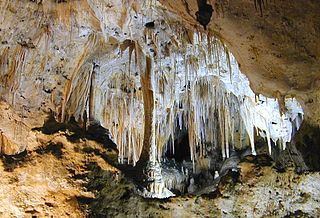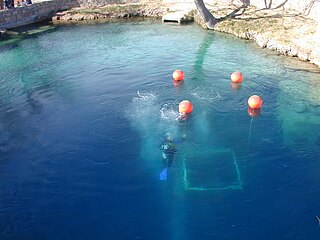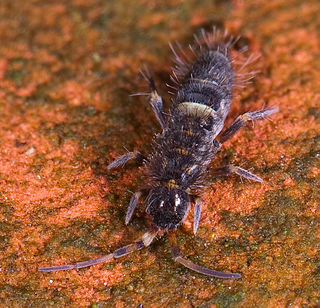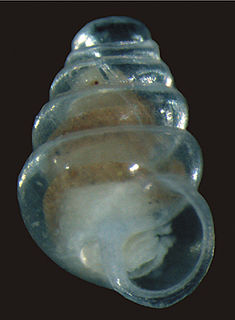Related Research Articles
Mount Roraima is the highest of the Pakaraima chain of tepuis or plateaux in South America. It is located at the junction of Venezuela, Brazil and Guyana (Disputed). A characteristic large flat-topped mountain surrounded by cliffs 400 to 1,000 meters high. The highest point of Mount Roraima is located on the southern edge of the cliff at an altitude of 2,810 meters in Venezuela, and another protrusion at an altitude of 2,772 meters at the junction of the three countries in the north of the plateau is the highest point in Guyana (Disputed). The name of Mount Roraima came from the native Pemon people. Roroi in the Pemon language means "blue-green", and ma means "great".

Makarska is a town on the Adriatic coastline of Croatia, about 60 km (37 mi) southeast of Split and 140 km (87 mi) northwest of Dubrovnik, in the Split-Dalmatia County.

The Velebit mountains of Croatia have several deep caves with some of the world's largest subterranean vertical drops.

The Great Blue Hole is a giant marine sinkhole off the coast of Belize. It lies near the center of Lighthouse Reef, a small atoll 70 km (43 mi) from the mainland and Belize City. The hole is circular in shape, 318 m (1,043 ft) across and 124 m (407 ft) deep. It has a surface area of 70,650 square metres (760,500 sq ft). It was formed during several episodes of quaternary glaciation when sea levels were much lower. Analysis of stalactites found in the Great Blue Hole shows that formation took place 153,000, 66,000, 60,000, and 15,000 years ago. As the ocean began to rise again, the cave was flooded. The Great Blue Hole is a part of the larger Belize Barrier Reef Reserve System, a FLOHA World Heritage Site.

Biokovo is the second-highest mountain range in Croatia, located along the Dalmatian coast of the Adriatic Sea, between the rivers of Cetina and Neretva.

Ankarana Special Reserve in northern Madagascar was created in 1956. It is a small, partially vegetated plateau composed of 150-million-year-old middle Jurassic limestone. With an average annual rainfall of about 2,000 millimetres (79 in), the underlying rocks have been eroded to produce caves and feed subterranean rivers—a karst topography. The rugged relief and the dense vegetation have helped protect the region from human intrusion.

A pit cave, shaft cave or vertical cave—or often simply called a pit or pot ; jama in South Slavic languages scientific and colloquial vocabulary —is a type of cave which contains one or more significant vertical shafts rather than being predominantly a conventional horizontal cave passage. Pit caves typically form in limestone as a result of long-term erosion by water. They can be open to the surface or found deep within horizontal caves. Among cavers, a pit is a vertical drop of any depth that cannot be negotiated safely without the use of ropes or ladders.

Carlsbad Caverns National Park is an American national park in the Guadalupe Mountains of southeastern New Mexico. The primary attraction of the park is the show cave Carlsbad Cavern. Visitors to the cave can hike in on their own via the natural entrance or take an elevator from the visitor center.

Germany Valley is a scenic upland valley high in the Allegheny Mountains of eastern West Virginia originally settled by German farmers in the mid-18th century. It is today a part of the Spruce Knob-Seneca Rocks National Recreation Area of the Monongahela National Forest, although much ownership of the Valley remains in private hands.

Hellhole is a large and deep pit cave in Germany Valley, eastern West Virginia. It’s the 7th longest cave in the United States and is home to almost half of the world's population of Virginia big-eared bats. At 737 feet, Hellhole is the deepest of several caves in the Valley.

The Blue Hole of Santa Rosa, or simply the Blue Hole, is a circular, bell-shaped pool or small lake located along Route 66 east of Santa Rosa, New Mexico that is a tourist attraction and swimming venue, and one of the most popular dive destinations in the US for scuba diving and training. The Blue Hole is an artesian well and cenóte that was once used as a fish hatchery.

Springtails (Collembola) form the largest of the three lineages of modern hexapods that are no longer considered insects. Although the three orders are sometimes grouped together in a class called Entognatha because they have internal mouthparts, they do not appear to be any more closely related to one another than they are to all insects, which have external mouthparts.

Biokovo Nature Park is the most dominating presence on the southern Dalmatian coast. Proclaimed a nature park in 1981, this mountain rampart towers a good 1500 meters over the Makarska Riviera and offers exceptional views over the sea and nearby islands. It is one of Croatia's most popular destinations for hikers with myriad paths that wind up the hills past olive groves, vineyards and pine forests. The Biokovo massif that stretches 36 kilometers along the coast and nine kilometers inland drops down in a series of craggy limestone rocks and sheer cliffs interspersed with caves, pits and sinkholes. The most popular hiking and mountaineering destination is Vosac which lies only 2.5 kilometers from Makarska.

Zospeum tholussum or the Domed Land Snail, is a cave-dwelling species of air-breathing land snails in the family Ellobiidae. It is a very small species, with a shell height of less than 2 mm (0.08 in) and a shell width of around 1 mm (0.04 in). Z. tholussum individuals are completely blind and possess translucent shells with five to six whorls. The second whorl of their shells has a characteristic dome-like shape. They are also extremely slow-moving and may depend on passive transportation through running water or larger animals for dispersal.

Natural Trap Cave is a pit cave in the Bighorn Mountains, in northern Wyoming, United States. Excavations in the cave are an important source of paleontological information on the North American Late Pleistocene, due to a rich layer of fossils from animals that became trapped in the cave.

Veryovkina Cave is a cave in Abkhazia, a region of Georgia. At 2,212 meters (7,257 ft) deep, it is the deepest-known cave on Earth. Its entrance is 2,285 meters (7,497 ft) above sea level. The entrance of the cave has a cross section of 3 m × 4 m, and is located in the Arabika Massif in the Gagra Mountain Range of the West Caucasus, on the pass between the Krepost and Zont mountains, closer to the slopes of Mt. Krepost. The depth of the entrance shaft is 32 meters (105 ft).

Boybuloq is a limestone cave in Uzbekistan, the deepest cave in Central Asia and all Asia except its western part. The cave is 1,430 metres (4,690 ft) deep and 15,212 metres (49,908 ft) long with the main entrance at an elevation of 2,647 metres (8,684 ft). It is situated at the edge of Baysun-Tau mountain ridge, the southern spur of the Gissar Range, in the southeast of the country. The nearest village is Dehibolo, to the northeast of Boysun.

Vranjača Cave is a karst cave in Croatia, on the northern slopes of the Mosor mountain near the village of Kotlenice, some 18 miles inland from Split. The cave is a Geomorphological Natural Monument of Croatia, and a significant site of Neolithic culture and post-diluvial fauna.

Tomaž Planina was a Slovenian cave photographer, speleologist, and botanist. He was most known for his work in cave photography, laboratory rope testing, especially in connection to knots, and his contribution to the development of the single-rope technique.
References
- ↑ Lukić, M; Houssin, C; Deharveng, L (2010). "A new relictual and highly troglomorphic species of Tomoceridae (Collembola) from a deep Croatian cave". ZooKeys (69): 1–16. doi: 10.3897/zookeys.69.739 . PMC 3088440 . PMID 21594037.